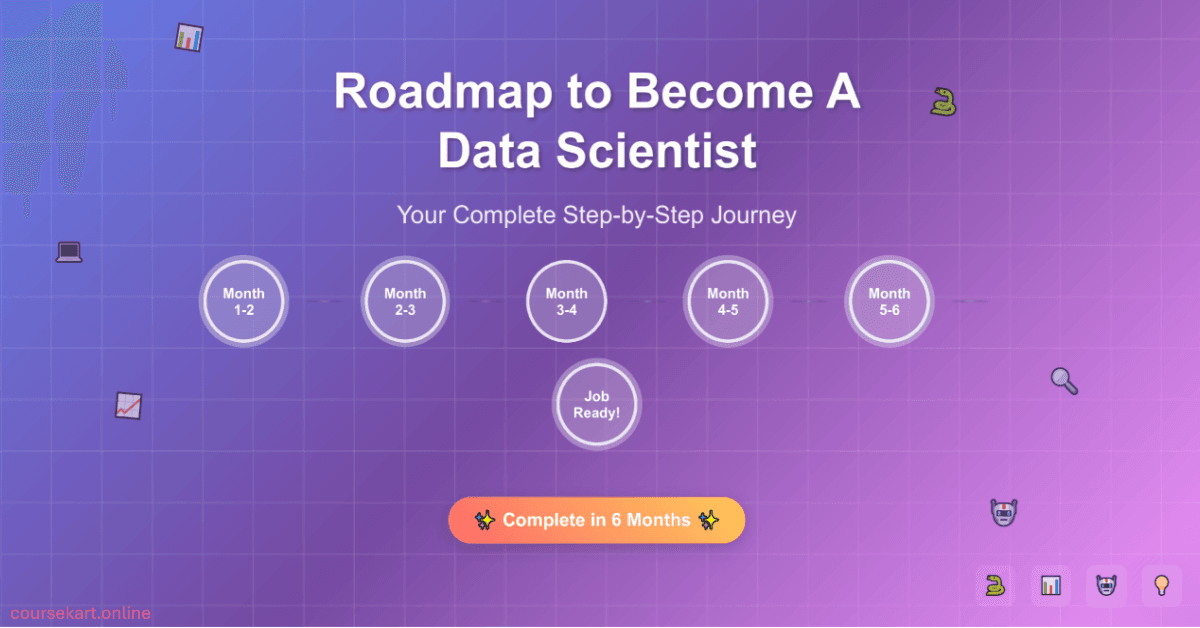Discover a step-by-step roadmap to become a data scientist in 6 months. Learn Python, SQL, statistics, and machine learning, and build portfolio projects to land your first data science role.
Professionals from a wide range of fields, including engineering, business, healthcare, and even the arts, are drawn to data science as one of the most sought-after career pathways today.
The abundance of data and the requirement for businesses to transform it into actionable insights are driving the demand.
Data science is regularly ranked as one of the top emerging careers by Glassdoor and LinkedIn, with competitive pay and opportunities for advancement across industries.
However, the crucial question still stands: Is it possible to become a data scientist in just six months? Yes, but with realistic expectations, it is the quick response.
In six months, you won’t become a senior-level expert. However, you can definitely develop the abilities required for an entry-level position or internship in data science with a targeted plan, dedicated study, and practical experience.
Consider it as building a solid foundation that you will continue to fortify as you gain experience.
I designed this six-month plan for individuals who want to start a career in data science, students who want to develop skills that are ready for the sector, and professionals who want to change fields.
With this guide, you can become a data scientist in just six months if you’re motivated, willing to put in regular time each week, and receptive to learning both the technical and analytical aspects of things.
Understanding the Role of a Data Scientist
Knowing exactly what a data scientist performs is crucial before delving into the roadmap. Fundamentally, data science is the process of extracting valuable insights from unstructured data to assist organizations in making more informed decisions.
Working with massive datasets, a data scientist cleans and processes them, applies statistical techniques, creates predictive models, and presents the results in reports and visualizations that are visually appealing. To put it briefly, they help close the gap between data and judgment.
You’ll need to hone a combination of technical and analytical abilities to be successful in this position. Probability and statistics serve as the cornerstones for data interpretation and result validation.
Proficiency in Python or R is essential for automating tasks and manipulating data. Additionally, you must comprehend machine learning, which underpins AI-driven insights and predictive modeling.
Furthermore, the ability to visualize data using programs like Tableau, Seaborn, or Matplotlib is necessary to convey findings to stakeholders who are not technical.
Last but not least, possessing domain knowledge, whether in e-commerce, healthcare, finance, or another area, allows you to successfully apply your abilities to real-world issues.
It’s also critical to differentiate the responsibilities of data scientists from those of other similar professions. Creating dashboards and reports to illustrate historical trends is one of the descriptive and diagnostic analytics that a data analyst specializes in.
In contrast, a machine learning engineer is more focused on implementing and expanding machine learning models into operational systems. Between these positions, a data scientist creates meaningful insights by fusing machine learning, programming, and statistical analysis with business context.
Read Also: Data Analyst Vs Data Scientist Vs ML Engineer: Which Role is Right for You?
Tools & Technologies You Must Learn
Learning the appropriate tools and technologies is essential if you want to become a data scientist in six months. These are the foundational elements that will enable you to develop models, work with real-world datasets, and cooperate with other experts in the area.
Programming is the first step in the process, and Python is the obvious choice for data science. Its libraries, Scikit-learn for machine learning, Pandas for data manipulation, and NumPy for numerical computing, make it a formidable force in modeling and analytics.
While most use cases are covered by Python, knowing R can be helpful if you wish to investigate academic research or sophisticated statistics; however, most industry tasks do not require it.
Data visualization is equally important because poorly articulated ideas lose their impact. While business intelligence products like Tableau or Power BI enable you to generate interactive dashboards that stakeholders can use directly, Python libraries like Matplotlib and Seaborn aid in the creation of intricate plots and charts.
Working with databases is another requirement for a data scientist, which calls for a basic mastery of SQL. Given that a large portion of the world’s data still exists in relational databases, being able to efficiently query, filter, and aggregate data is made possible by SQL.
To begin implementing fundamental machine learning algorithms, including clustering, classification, and regression, you will use Scikit-learn. You can gain practical expertise with neural networks and AI applications as you progress by investigating deep learning frameworks like TensorFlow or PyTorch.
Additionally, collaboration and project management are important, which is why platforms like GitHub and version control systems like Git are crucial. They let you collaborate with others, keep tabs on code changes, and publicly display your work.
Finally, you may have an advantage if you have any experience with cloud systems like Microsoft Azure, Google Cloud Platform (GCP), or Amazon Web Services (AWS).
Learning how to use cloud services for data storage, computing, or model deployment, even at a basic level, can get you ready for contemporary data science procedures used in business.
6-Month Roadmap to Become a Data Scientist (Month-by-Month Plan)
Month 1: Foundation in Python, Math & Statistics
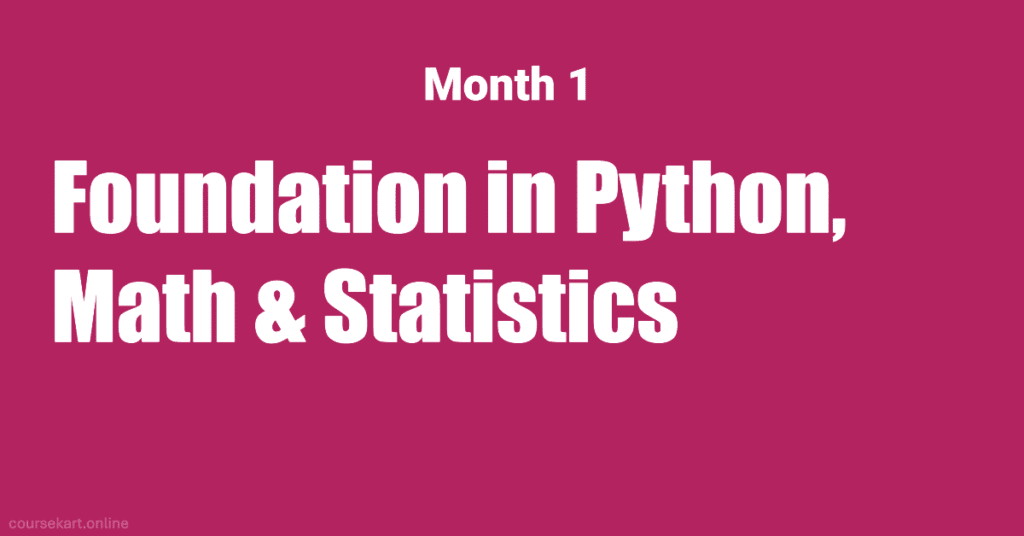
The goal of the first month is to lay a solid foundation. Learn the fundamentals of Python first, including loops, functions, and data structures like lists, dictionaries, and sets. After you feel at ease, proceed to more fundamental libraries like Pandas for data processing and NumPy for managing arrays and mathematical calculations.
Spend time studying mathematics for data science in addition to coding. Concentrate on probability to comprehend uncertainty and unpredictability, linear algebra to understand vectors and matrices, and the fundamentals of calculus to understand optimization strategies.
Despite their initial abstract nature, these ideas are the foundation of many machine learning algorithms.
Lastly, explore statistics, especially inferential statistics (p-values, hypothesis testing, and confidence intervals) and descriptive statistics (mean, median, variance, and standard deviation).
These will assist you in critically analyzing facts and drawing well-informed conclusions. By the end of the first month, you need to feel at ease managing tiny datasets, writing Python scripts, and using statistical techniques to solve practical issues.
Month 2: Data Wrangling & Visualization
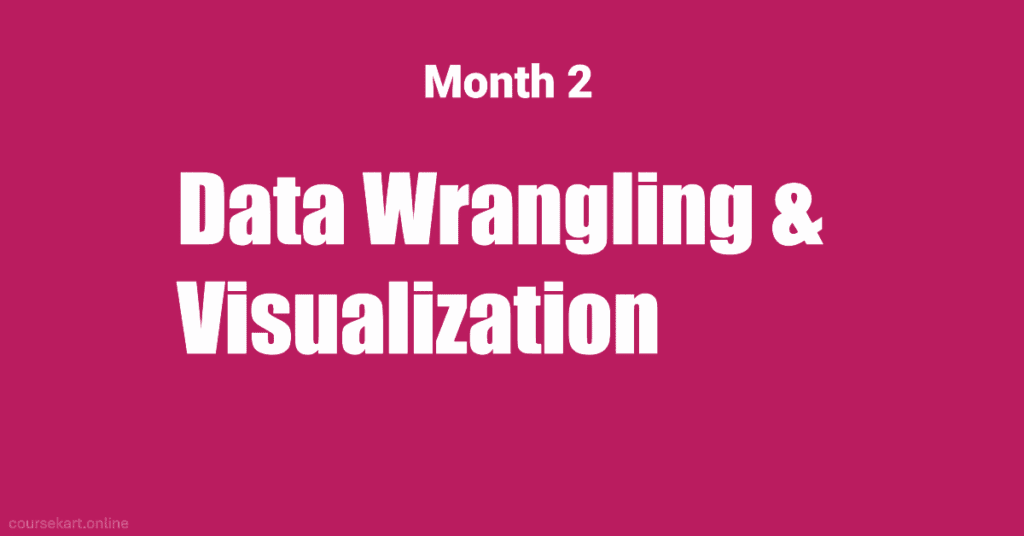
After you have a solid foundation, you can start working on data wrangling, which is the process of cleaning and getting raw data ready for analysis.
This includes dealing with missing values, eliminating duplicates, standardizing data formats, and converting categorical variables into representations that may be used.
Here, Pandas will be your go-to library, and now is the ideal moment to delve deeply into its features, which include grouping, merging, and reshaping datasets.
Data visualization is the next skill to master since it makes patterns and trends easy to spot quickly. Charts, histograms, scatter plots, and heatmaps may all be made with libraries like Matplotlib and Seaborn.
For any aspiring data scientist, the ability to communicate a story using images is essential.
Engage in introductory projects like Exploratory Data Analysis (EDA) to put your knowledge into practice. To gain insights, select a publicly accessible dataset, such as COVID-19 case data or Titanic survivor data, and examine it.
These projects will help you develop your abilities and provide content for your portfolio in data science.
Month 3: SQL & Databases + Advanced Statistics
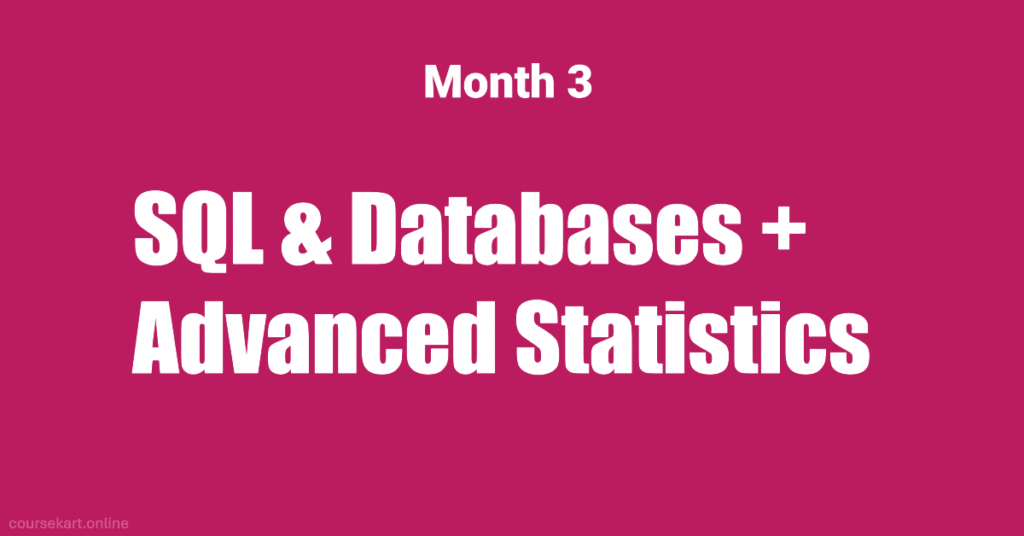
Given that the majority of data in the real world is saved in organized formats, it’s time to go beyond Python by the third month and hone your database skills.
Learn how to organize, filter, and join datasets by starting with SQL queries. Get comfortable using subqueries and procedures like JOIN and GROUP BY, which let you manage intricate data requests.
Since many different businesses rely on different data formats, learn how to handle unstructured data as well, including text or JSON files. You will be able to operate across various data pipelines with the freedom this experience will provide.
In parallel with SQL, enhance your knowledge of statistics by concentrating on more complex ideas like ANOVA (group comparison), correlation and regression analysis (modeling relationships between variables), and hypothesis testing (validating assumptions). When making decisions based on data, these are commonly employed.
Create a small project that combines Python and SQL for real-world use. A pipeline that pulls data from a database, uses Pandas to clean it, and then does statistical analysis is one example.
The tasks you will encounter as a professional data scientist are similar to those in this type of project.
Month 4: Machine Learning Basics
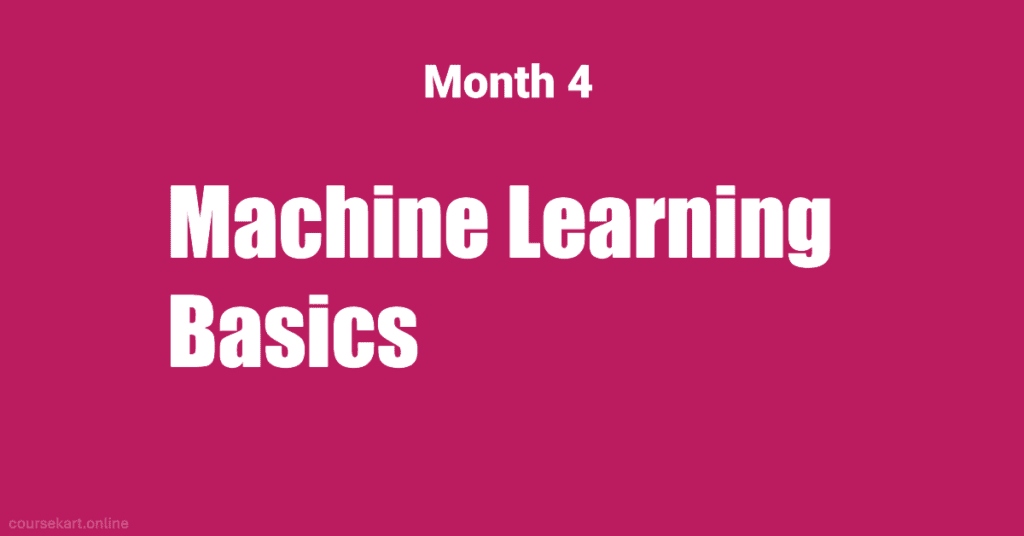
You enter the fascinating field of machine learning in month four. Start by comprehending the distinction between unsupervised learning, in which models find hidden patterns in unlabeled data, and supervised learning, in which models learn from labeled data.
After that, explore clustering methods like K-Means for data grouping, classification algorithms for categorical results, and regression algorithms for continuous value prediction.
At this point, pay attention to the intuition underlying the algorithms rather than just using them. What is the purpose of linear regression? When is it appropriate to switch from logistic regression to decision trees?
Feature engineering is another essential ability, which entails turning unprocessed data into useful inputs for machine learning models. Use this in conjunction with model evaluation methods like F1-score, precision, recall, cross-validation, and confusion matrices to gauge model performance.
Finish out this month with little crafts. Examples include grouping customers, constructing a spam email classifier, and forecasting home values. These projects will provide you with good portfolio pieces and help you reinforce your mastery of ML concepts.
Month 5: Advanced ML + Real-World Applications
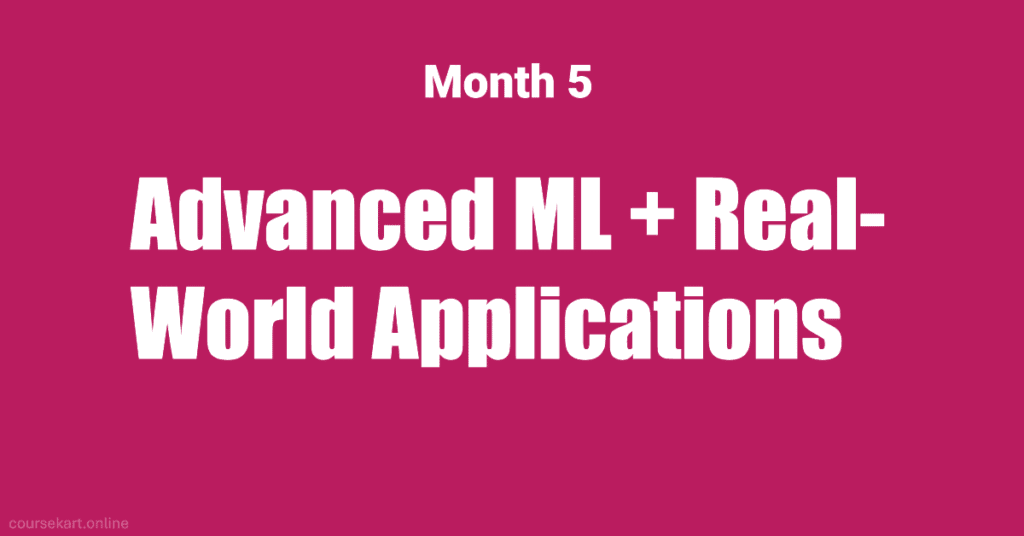
You should be at ease with machine learning basics by Month 5, at which point you can move on to more complex methods and practical uses. Start with ensemble techniques such as XGBoost, Random Forest, and Gradient Boosting.
These models are popular in contests and the industry because they combine numerous learners to obtain increased accuracy, making them powerful.
Next, investigate an overview of deep learning with frameworks such as PyTorch or TensorFlow. Focus on comprehending the fundamentals of neural networks at this point, including how layers, activation functions, and optimization operate.
While mastering complex architectures is not yet necessary, working with basic models will help you stand out from the crowd.
Time series forecasting is another crucial ability that is essential for sectors like supply chain, retail, and finance. Discover techniques like ARIMA and use machine learning techniques to forecast patterns across time.
Learn the fundamentals of Natural Language Processing (NLP) as well. Before experimenting with sentiment analysis or text classification models, start with text preparation methods like tokenization, stemming, and lemmatization.
Take on a real-world project to tie everything together, such as developing a sentiment classifier for social media posts, predicting customer attrition, or evaluating stock price data.
These assignments will demonstrate your capacity to use cutting-edge machine learning approaches to solve real-world business issues.
Month 6: Portfolio, Deployment & Job Prep
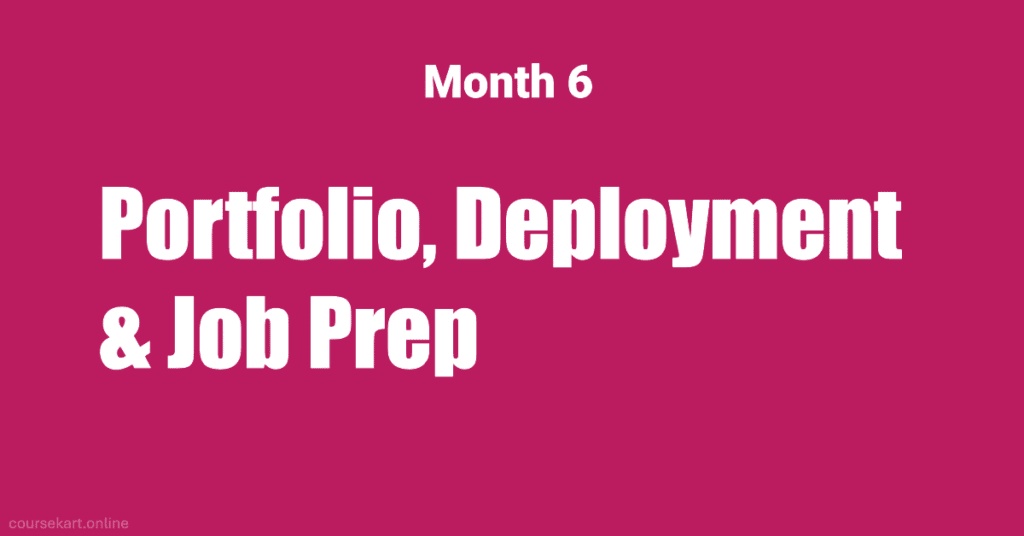
Creating career-ready outcomes from your learning is the focus of the last month. Build and refine your portfolio projects on sites like GitHub and Kaggle to start.
To make your work easily comprehensible to prospective employers, make sure every project has a clear problem statement, methodology, outcomes, and visualizations.
Next, become familiar with the fundamentals of deployment, as many businesses appreciate data scientists who can put models into action.
Simple online apps that let users interact with your models can be made with tools like Flask, FastAPI, or Streamlit. A simple deployment project, such as a web application that forecasts real estate prices, might add a unique touch to your portfolio.
Focus on getting ready for the job at the same time. Update your resume to emphasize projects, technical expertise, and problem-solving capabilities. To grow your network, highlight your projects, add pertinent keywords to your LinkedIn profile, and interact with the data science community.
Lastly, review popular data science interview questions and practice mock sessions to get ready for interviews. Anticipate inquiries on case studies, machine learning principles, Python coding issues, and SQL queries.
The culmination of your six-month journey will be the completion of a capstone project, which is an extensive end-to-end data science project that covers data collection, cleaning, modeling, and deployment.
Data Scientist Roadmap – 6 Months
| Month | Focus Areas | Key Topics & Skills | Mini Projects |
|---|---|---|---|
| Month 1 | Foundation in Python, Math & Statistics | Python basics (loops, functions, data structures), NumPy, Pandas, Linear Algebra, Probability, Calculus basics, Descriptive & Inferential Statistics | Basic data analysis on a small dataset |
| Month 2 | Data Wrangling & Visualization | Data cleaning & preprocessing, Pandas deep dive, Matplotlib, Seaborn | Exploratory Data Analysis (EDA) on real dataset |
| Month 3 | SQL & Databases + Advanced Statistics | SQL queries (joins, group by, subqueries), Handling structured/unstructured data, Hypothesis testing, Regression analysis | SQL + Python data pipeline |
| Month 4 | Machine Learning Basics | Supervised vs Unsupervised Learning, Regression, Classification, Clustering, Feature engineering, Model evaluation | Predictive models (e.g., spam detection, house price prediction) |
| Month 5 | Advanced ML + Real-World Applications | Ensemble methods (Random Forest, XGBoost), Intro to Deep Learning (TensorFlow/PyTorch basics), Time series forecasting, NLP basics (sentiment analysis) | ML model on real-world dataset |
| Month 6 | Portfolio, Deployment & Job Prep | Portfolio building (GitHub, Kaggle), Deployment basics (Flask, FastAPI, Streamlit), Resume & LinkedIn optimization, Mock interviews | Capstone project (end-to-end ML project with deployment) |
Recommended Learning Resources
With the appropriate resources at your disposal, following the six-month roadmap is considerably simpler. Focus on reputable platforms and resources that are regarded as reliable by experts in the subject rather than attempting to learn from unreliable sources.
Start with the structured learning paths offered by online courses. Programs ranging from basic to intermediate in Python, statistics, machine learning, and data visualization are available on platforms such as Coursera, Udemy, DataCamp, and freeCodeCamp.
For instance, the Python for Data Science and Machine Learning Bootcamp on Udemy and the IBM Data Science Professional Certificate on Coursera are great places for novices to start.
Another trustworthy method to improve your comprehension is to read books. Many people believe that Aurélien Géron’s book Hands-On Machine Learning with Scikit-Learn, Keras, and TensorFlow is essential reading for anyone new to machine learning.
Theodore Petrou’s Pandas Cookbook offers useful recipes for working with real-world datasets in Python and data processing.
Use tools like Kaggle, where you can explore public datasets, compete, and learn from other data scientists’ notebooks, to hone your skills on a regular basis. With its authentic interview-style issues, LeetCode is an excellent platform for practicing coding, particularly in Python and SQL.
Lastly, remember that communities have a lot of power. Joining communities like LinkedIn data science groups, Reddit’s r/datascience, or active Slack channels can help you remain up to date with trends, learn from others, and perhaps find employment prospects.
Your ability to network with experts and other students might be just as beneficial as the technical abilities you acquire.
Projects You Should Include in Your Portfolio
A compelling portfolio frequently makes the difference between getting an interview and getting skipped over.
Companies want to see how you use your knowledge to address practical issues, not just what you know. Because of this, your six-month trip should involve initiatives that address many topics of data science.
Take an exploratory data analysis (EDA) project as a starting point. Use descriptive statistics and visualization to extract insights from a real-world dataset, such as e-commerce sales, COVID-19 data, or Netflix viewing patterns.
EDA projects showcase your capacity to sort through jumbled data, spot trends, and create a narrative based on facts.
Add a predictive modeling project after that, in which you use classification or regression procedures to address a real-world issue.
For instance, you may create a model that can identify spam emails, categorize loan applications as safe or risky, or forecast home prices. These projects demonstrate your understanding of the foundations of machine learning.
Additionally, a SQL + Python data pipeline project is essential. It demonstrates your capacity to retrieve data from databases, utilize Pandas to clean and transform it, and then produce insightful outputs.
Candidates who can bridge the gap between raw data storage and datasets that are ready for analytics are highly valued by many employers.
Add a Natural Language Processing (NLP) project to demonstrate your interest in cutting-edge uses. This might be as straightforward as using Twitter data for sentiment analysis or as complex as building a rudimentary chatbot.
In domains such as product feedback analysis, social media analytics, and customer support, natural language processing (NLP) is extremely pertinent.
A capstone project, which is an end-to-end machine learning pipeline that entails data collection, wrangling, feature engineering, model building, evaluation, and deployment, should be the final component to complete your portfolio.
Employers may observe the model in operation when the project is hosted on GitHub and deployed using Streamlit or Flask, which enhances its impact.
Common Challenges and How to Overcome Them
There are challenges on every learning path, and becoming a data scientist in six months can occasionally feel overwhelming. Understanding typical obstacles and how to overcome them will keep you motivated and consistent throughout the process.
Among the most significant obstacles are information overload and imposter syndrome. As there are so many tools, frameworks, and buzzwords in data science, novices frequently feel inadequate or that they will never catch up.
Remembering that even seasoned data scientists are not experts is crucial. Learn the fundamentals of Python, SQL, statistics, and basic machine learning initially, then work your way up to mastering all the tools at once.
Small victories, such as finishing a small project, can significantly boost confidence.
Another difficulty is striking a balance between theory and practical application. It’s simple to become lost in tutorials and study one course after another without using what you’ve learnt.
Use the 70-30 rule to steer clear of this trap: dedicate roughly 70% of your time to practicing on datasets and projects and 30% to learning theory.
Use a brief real-world example to test any new idea you learn right away. This method helps you develop your portfolio while also reinforcing what you’ve learned.
Lastly, there is the problem of managing time during a six-month sprint that is so demanding. Many students attempt to upskill while balancing employment, school, or personal obligations.
Instead of overpowering monthly targets, the plan should be divided into weekly milestones. Set out specific times every day, even if it’s only two concentrated hours, and treat them as appointments that you can’t skip. Cramming is never as effective as consistency.
It will be simpler for you to stay on course and finish your path to becoming a data scientist if you tackle these obstacles head-on.
Career Preparation After 6 Months
It’s a significant accomplishment to finish a six-month data science roadmap, but the true difficulty starts when you enter the workforce. In order to increase your chances of success, you must strategically position yourself for entry-level positions, bundle your talents, and highlight your projects.
Start with your cover letter and resume. Technical abilities (such as Python, SQL, and ML libraries), portfolio projects (including links to GitHub or Kaggle), and any pertinent degrees or certifications should all be highlighted on your resume.
It should be no more than one page, and it should include quantifiable results from your efforts. Additionally, a customized cover letter can demonstrate to potential employers how your abilities meet their needs.
Opportunities are often obtained through networking. Engage with the data science community, write brief pieces about your learning experiences, and highlight your projects to make the most of your LinkedIn presence.
By participating in Kaggle competitions, you can meet other practitioners and hone your talents. Furthermore, participate in hackathons and virtual or in-person meetups to network with industry experts.
Developing relationships can provide you with a competitive advantage, as many data science positions are filled through referrals.
Be realistic while applying for entry-level positions. You can begin with roles like Data Analyst, Junior Data Scientist, or Machine Learning Engineer Intern, while getting the title “Data Scientist” may be the end goal.
These positions will provide you with the chance to use your abilities in practical situations, acquire useful experience, and progressively graduate into more complex duties.
Entry-level data science positions have a wide range of pay expectations based on industry, organization size, and location.
Beginners in the United States can anticipate earning between $65,000 and $90,000 per year; however, in India, the median range for freshers is ₹6–10 LPA.
Data scientists frequently see quick advancement with steady skill improvement and experience, advancing into mid-level and senior posts with much better pay in a matter of years.
Soon after finishing the six-month roadmap, you’ll be ready to launch your career in data science by fusing technical preparation with astute job-hunting techniques.
Conclusion & Final Motivation
Although becoming a data scientist in six months is a lofty goal, this route demonstrates that it is doable with the correct attitude and commitment.
You progress from developing a foundation in Python, statistics, and arithmetic over the course of six months to managing real-world datasets, mastering machine learning, and ultimately refining a portfolio that appeals to employers.
Your path becomes organized and progressive as each month builds upon the one before it.
The main lesson is straightforward: consistency and practice are more important than perfection. You need to get your hands filthy with projects, experiments, and Kaggle challenges; watching tutorials or reading books won’t make it.
You go closer to being prepared for the industry with each dataset you examine, model you develop, and visualization you provide.
Keep in mind that you don’t have to be an expert before applying for your first job. Candidates who can use data to solve actual problems are what recruiters are looking for, not someone who is an expert in every method or technology.
You’ll stand out from the crowd if you can clearly convey your thought process and show that through your efforts.
Therefore, don’t let impostor syndrome stop you from being consistent and learning new things. Your first job is only the beginning of your path into data science.
Focus, perseverance, and curiosity will help you acquire your first job and eventually develop into a highly trained data expert.
FAQs on Becoming a Data Scientist in 6 Months
Is it really possible to become a data scientist in 6 months?
Yes, it is possible to become a data scientist in 6 months, but with realistic expectations. You can certainly get the fundamental skills, Python, SQL, statistics, and machine learning, necessary for an internship or entry-level position, even though you might not become an expert at the senior level in such a short amount of time. Disciplined time management, practical tasks, and regular practice are essential for success.
Do I need a degree to become a data scientist?
While not required, a formal degree in mathematics, statistics, or computer science can be beneficial. Online courses, boot camps, and self-study are common ways for professionals to get started in data science. The capacity to address real-world problems, exhibit a solid project portfolio, and exhibit practical abilities are more important than a degree.
What math is required for data science?
You will require knowledge of linear algebra, probability, statistics, and the fundamentals of calculus. Probability and statistics are crucial for analysis and hypothesis testing, linear algebra aids in the comprehension of data structures and machine learning algorithms, and calculus is used in model optimization. You don’t have to master mathematics; simply concentrate on data science-related practical concepts.
Python vs R: Which one should I learn first?
Python is the greatest option for the majority of novices. It is widely used in industry for data engineering and machine learning, and it boasts a large ecosystem of libraries, including NumPy, Pandas, Scikit-learn, and TensorFlow. R is great for university research and advanced statistical analysis, but starting with Python will increase your chances of landing a data science job.
What projects impress recruiters the most?
Recruiters seek end-to-end projects that demonstrate your ability to handle actual business problems in addition to your technical proficiency. Examples include time series forecasting, SQL + Python pipelines, sentiment analysis using natural language processing, and predictive modeling on actual datasets. Capstone projects involving the collection, cleaning, analysis, and deployment of a model are especially noteworthy since they showcase the entire data science process.
Share Now
Discover more from coursekart.online
Subscribe to get the latest posts sent to your email.

